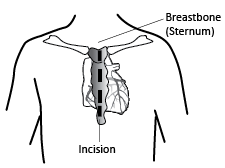One person can stay with you in the pre-operative waiting area until you’re taken to the operating room.
A lot will be happening here. You can ask questions if you have any. This is where you’ll meet your surgical team.
Some of the people on your surgical team are:
- nurses
- anesthesiologist -doctor who gives you medicine to keep you unconscious (asleep)and not feel pain during surgery
- surgeon
- perfusionist - operates the heart-lung machine
What you can expect:
- Your identification will be checked against your chart.
- You’ll get a warm blanket.
- You’ll get medicine that will help you relax if you haven’t had any yet.
- You may have oxygen started.
Once everything is done, you’ll be taken to the operating room.
The Operating Room
It’ll be a busy time again as your team gets you ready for surgery. By this time, the medicine to help you relax should be working. If you find that you’re anxious or uncomfortable, please tell someone on your team.
- A nurse will check your identification against your chart one more time.
- You’ll get help to move from your stretcher to the operating table. The surgical team will make sure you’re comfortable.
- Monitors will be attached to record your heart function, blood pressure, and the amount of oxygen in your blood. Your condition is always being monitored during surgery.
- Your anesthesiologist will give you medicine in your intravenous (IV) to make you sleep.
- Once you’re asleep, the anesthesiologist will place a breathing tube (called an endotracheal tube) through your mouth and into your throat. It’s then connected to a machine that breathes for you while you’re asleep.
- If you’re having CABG surgery, the arteries or veins needed for the grafts will be taken and prepared. Your surgery will begin once that’s done.
While the surgeon works on your heart you may be connected to a heart-lung machine (cardiopulmonary bypass machine), which takes over the work your heart and lungs do. Some surgeons don’t use the heart-lung machine for CABG surgery.
The perfusionist always watches the heart-lung machine. Once the surgery is done, the machine will do less and less work as your heart and lungs take over again.

In most cases, when the surgery is finished your breastbone will be closed with 6 or 7 thin stainless steel wires. These wires rarely cause any problems and will stay in for the rest of your life. Once your other incisions are stitched up, a chest drainage tube will be inserted to take away any fluid that builds up in your chest because of the surgery.
In some cases your incisions will be in a different location, depending on the type of surgery you have. In surgery, temporary pacing wires, are attached to your heart in case your heart beat becomes irregular and your heart needs some help getting back to a regular rhythm.
